🥀🌾Notes on Anatomy of Flowering Plants🥀🌾
Depending upon distribution of stomata, the leaves are :
(a) Apple-mulberry type: e.g. Oxalis, Mulberry, Apple.
(b) Potato type: e.g. Bifacial (dorsiventral leaves of pea, bean, tomato).
(c) Oat type: e.g. Suberect (isobillateral) leaves of most grasses and cereals (monocotyledens).
(d) Nymphea type: e.g. Floating leaves of Nelumbo, Nymphia, water lily.
(e) Potamogeton type: e.g. Submerged plants like Hydrilla, Vallisneria, Potamogeton.
(iv) Trichomes: These are epidermal outgrowths present temporarily or permanently on almost all plant parts.
(v) Root hairs: They are enlargements of special epiblema cells called trichoblasts and occurs in a particular zone of young root called root hair zone.
(2) Ground or Fundamental tissue system: Ground tissue system includes all the tissues of plant body except epidermal tissue system and vascular tissues. It forms the bulk of body. This tissue system mainly originates from ground meristem. The ground tissues constitute the following parts :
(i) Cortex: It lies between epidermis and the pericycle. The cortex is distinct in dicotyledons but not in monocotyledons where there is no clear demarcation between cortex and pith. It is further differentiated into :
(a) Hypodermis: It is collenchymatous in dicot stem and sclerenchymatous in monocot stem. It provides strength.
(b) General cortex: It consists of parenchymatous cells. Its main function is storage of food.
(c) Endodermis (Starch sheath): It is mostly single layered and is made up of parenchymatous barrel shaped compactly arranged cells.
(ii) Pericycle: It is a single layered or multilayered cylinder of thin-walled or thick-walled cells present between the endodermis and vascular tissues. In some cases, the pericycle is made up of many layers of sclerenchymatous cells (Cucurbita stem) or in the form of alternating bands of thin-walled and thick-walled cells (Sunflower stem).
(iii) Pith or Medulla: It occupies the central part in dicot stem, and monocot root. It is mostly made up of parenchymatous cells. in dicot root pith is completely obliterated by the metaxylem elements. In dicot stem the pith cells between the vascular bundles become radially elongated and known as primary medullary rays or pith rays.
(3) Vascular tissue system: The central cylinder of the shoot or root surrounded by cortex is called stele. The varying number of vascular bundles formed inside the stele constitute vascular tissue system. Xylem, phloem and cambium are the major parts of the vascular bundle. Vascular bundle may be of following types:
(i) Radial: The xylem and phloem strands alternate with each other separated by parenchymatous cells. such kinds of vascular bundles are called radial and found mainly in roots.
(ii) Conjoint: A vascular bundle having both xylem and phloem together, is called conjoint. Normally the xylem and phloem occur in the same radius. They occur in stems. Such vascular bundles are of two types:
(a) Collateral: A vascular bundle in which the phloem lies towards outerside and xylem towards inner side, is called collateral, e.g., Sunflower.
(b) Bicollateral: A vascular bundle having the phloem strands on both outer and inner side of xylem, is called bicollateral. e.g., Cucurbita.
